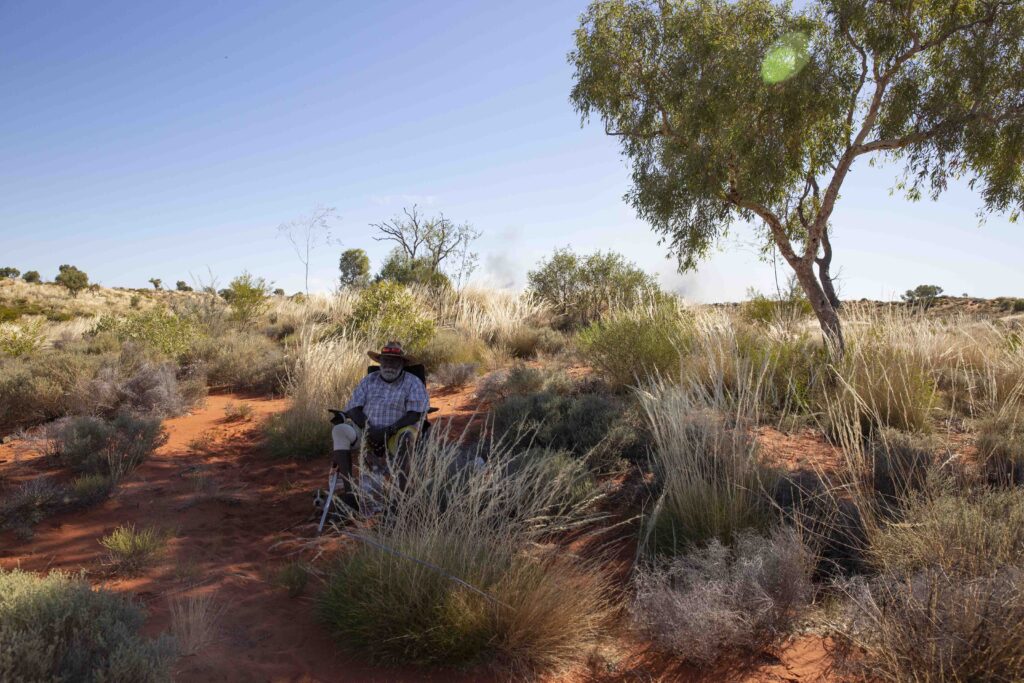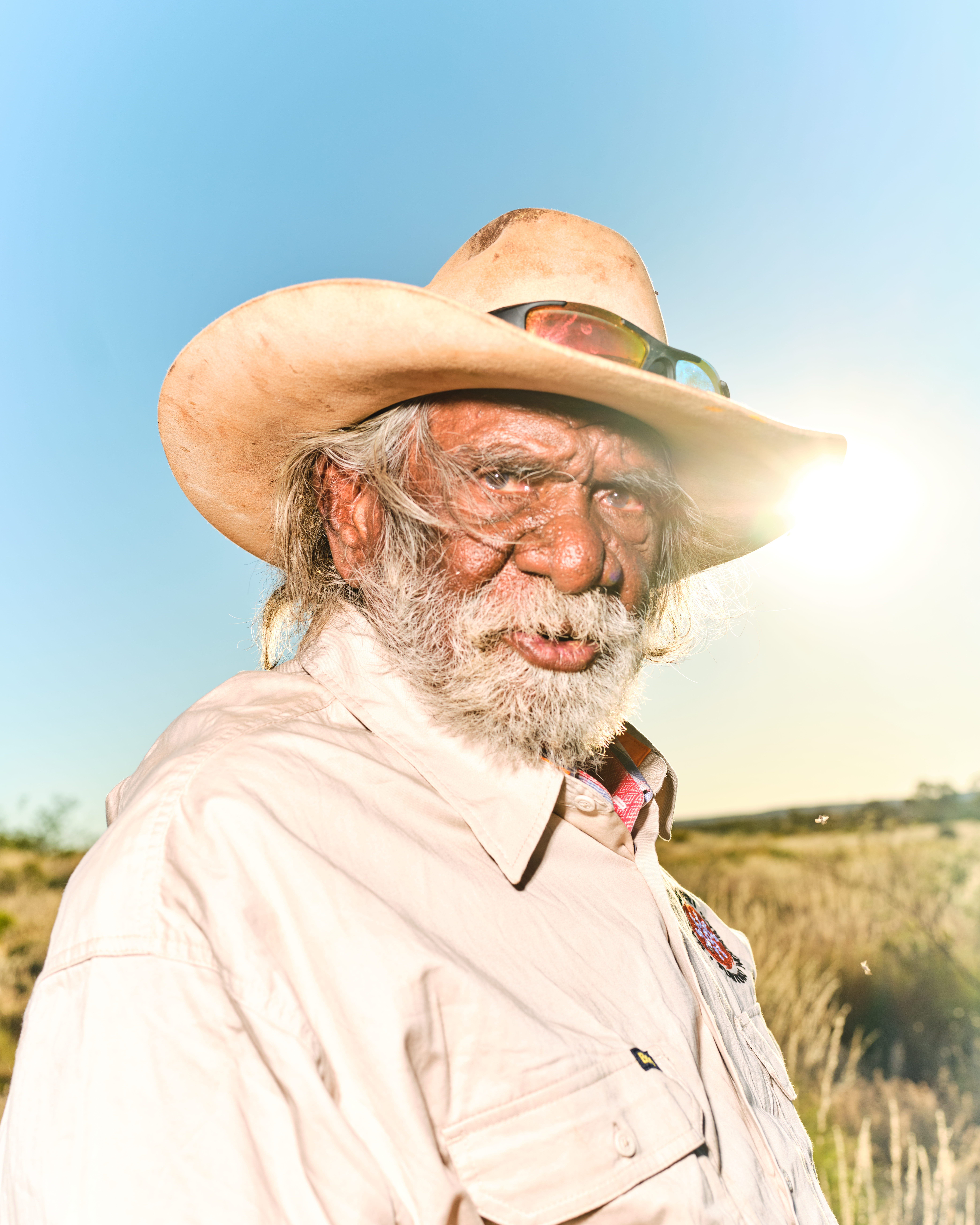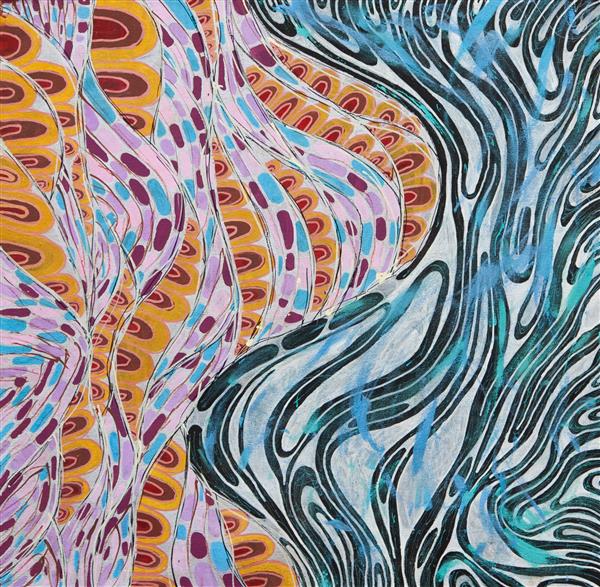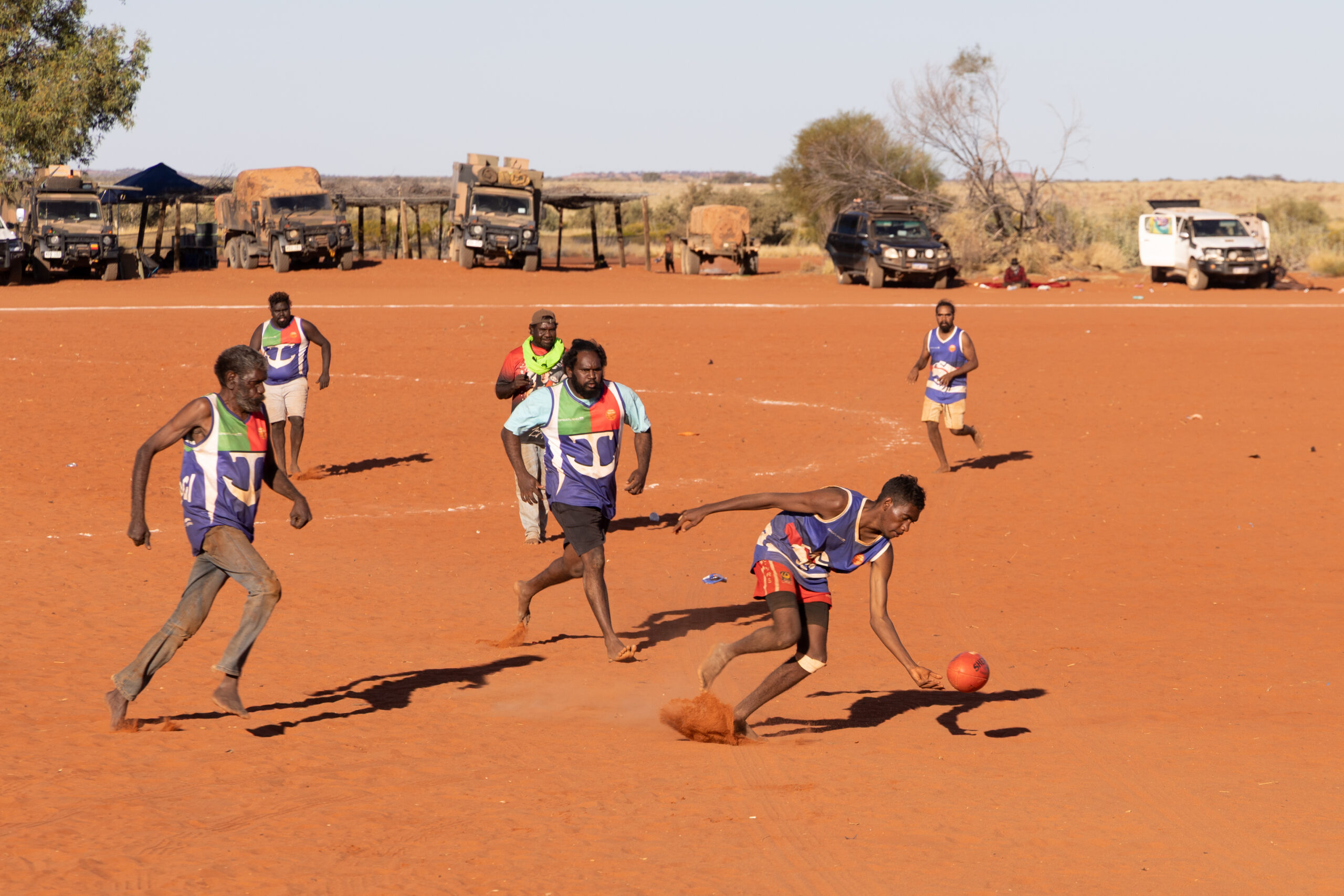Last month, Outstation Gallery hosted a sell-out solo exhibition by senior Martumili Artist and cultural leader, Muuki Taylor OAM. Featuring 23 paintings of Kulyakartu, Muuki’s home Country, the exhibition celebrated not only his artistic achievements but also his extraordinary life as a pujimanpa (traditional, desert dweller), lawman and community leader.

From 1–16 August, Outstation Gallery—one of Australia’s leading contemporary Aboriginal art galleries—hosted Muuki Taylor OAM, a landmark solo exhibition. The show featured twenty-three new works, each a depiction of Kulyakartu, one of the principal sites where Muuki camped as a young man while living a pujiman (traditional, desert-dwelling) life.
Since he began painting in 2007, Muuki has focused almost exclusively on Kulyakartu, occasionally depicting nearby soaks and rockholes such as Kiriwirri, Tayiku, and Wirnpa. Kulyakartu is flat grass Country at the northern end of the Martu homelands, near the Percival Lakes region of Western Australia’s Great Sandy Desert. The area abounds with parnajarrpa (goanna), wild cats, and lunki (witchetty grub), but holds no permanent water.
As such, Muuki’s family would travel here annually following the wantajarra (wet season).
Muuki recently travelled back to the lands that sustained him as a young man on a profoundly moving trip back to Kulyakartu with KJ. For the first time since his twenties he was reunited with extended family who had been dispersed from the lands surrounding Kulyakartu across the Pilbara and Kimberley in the 1960s. “I been there sit down. I been walk round them waterhole. I been crying. I been look every waterhole. We all been come, Kulyakartu people… My Country. Kulyakartu belong all the Martu people.” In a remarkable parallel, this trip occurred at the same time as his exhibition in Darwin.
Muuki’s works are instantly recognisable: layers of organic dotting vibrate across the canvas in radiant palettes to depict the seasonal shifts and cycles of fire, regrowth, and renewal. These paintings embody an encyclopaedic knowledge of Muuki’s Country, from its living water sources and geographical formations to the patterns of burning that sustain biodiversity, reduce chances for destructive bushfires, and aid traditional hunting. The cyclical stages of burning—nyurnma (freshly burnt Country), waru-waru (early regrowth), nyukura (mature plants fruiting), manguu (spinifex ready to burn again), and kunarka (old growth posing a risk of destructive bush fires)—are often visible in Muuki’s works, represented through intricate patchwork compositions. In this way, his paintings are both artworks and ecological maps. As Muuki explains, “I been grow up there, Kulyakartu. I remember everything. I know them water places. Little rockhole, everywhere, yinta (permanent spring) belong there. That’s the old people learn. My mummy and daddy been show me.”
Muuki’s artistic achievements are widely recognised: he has twice been a finalist in the prestigious National Aboriginal and Torres Strait Islander Art Awards (NATSIAA), his paintings have been exhibited across Australia and internationally, and he features in major collections including the National Museum of Australia and the Art Gallery of Western Australia.
Beyond his impressive artistic career, however, Muuki’s life story is in itself extraordinary. Born around 1945 at Wayinkurangu in the Percival Lakes region, he lived traditionally in the desert with his family until the 1960s, when they were among the last Martu to leave the desert. He recalls: “Long ago we were living pujiman life. Our people took us about and grew us up… We would see aeroplanes, then we would run and keep quiet in the bushes. We didn’t know what it was. We had never seen a white man.” (Muuki Taylor as translated by Kanyirninpa Jukurrpa). Since those days, Muuki has become a foundational member of the Parnngurr community, a respected lawman, and a senior cultural advisor with the Martu organisation Kanyirninpa Jukurrpa (KJ). In 2023 he was awarded the Order of Australia Medal (OAM) for his service to Western Desert Aboriginal communities—a rare and deeply deserved honour.
As co-founder of KJ, Muuki has played a vital role in shaping the ranger, cultural and social programs that have strengthened Martu identity and connection to Country, supporting intergenerational knowledge transfer and ecological stewardship. Yet at the heart of his work remains a simple, powerful desire: to pass knowledge on; “Young people, I gotta show him waterhole for Kulyakartu, how to leave it [clear Kulyakartu’s waterholes] when it’s finished. [Waterholes are sites that require maintenance, including digging to increase flow, clearing out surrounding growth, and cleaning up after sullying by camels or cattle.] Young people gotta look after old people’s Country.”
It is this same motivation that continues to drive his painting practice. Each canvas is not just an artwork but a teaching tool—a way of continuing to speak for his Country and record, share, and safeguard Martu knowledge for future generations. “I been painting for everybody. Old people gotta paint him.”
The recent Outstation exhibition highlighted the breadth and depth of Muuki’s art practice as well as his cultural and community impact. Speaking of the exhibition, Outstation Gallery co-founder Paul Johnstone acknowledges his achievements in every sense: “Realising a solo exhibition by Muuki Taylor at Outstation Gallery was overdue. Muuki is such an important cultural elder; a spiritual leader and an incredible artist. … Presenting [these works on Kulyakartu] as a single body in an intimate setting [meant that] as viewers entered the space, they were genuinely affected by the beauty and magic shining through the canvas – listening to the whispers of Martu Country.”
Through his art and his leadership, Muuki Taylor OAM embodies the unbroken connection between Martu people and their Country. His exhibition at Outstation Gallery was more than a display of extraordinary paintings—it was a celebration of a lifetime dedicated to culture, community, and care for Country.
Words by Ruth Leigh in conversation with Muuki Taylor OAM
Article hero image credits: Duncan Wright, 2024



